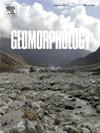Morphological dynamics and vegetation interactions in coastal dunes: UAV-based insights from Pingtan Island, China
IF 3.1
2区 地球科学
Q2 GEOGRAPHY, PHYSICAL
引用次数: 0
Abstract
The interactions between vegetation and morphology on coastal dunes are essential for understanding and managing biogeomorphological processes. While these interactions have been studied at dune field or transect scales over weekly, annual, and decadal timescales, the coupling of individual dunes across several types at seasonal scales remains poorly understood. We selected nine coastal dunes of three types along Tannan Bay on Pingtan Island, China. Seasonal investigations combining unmanned aerial vehicle-based LiDAR monitoring and vegetation surveys were conducted to evaluate vegetation and dune morphology dynamics and analyze their interactions. The results revealed that (1) sediment accumulation increased from the beach to the windward slope but decreased near the dune crest and leeward slope. This accumulation was significant in winter and was controlled by spatiotemporal vegetation dynamics, typhoons, and topographic variations. (2) Coastal dune morphology influenced vegetation distribution, with vegetation on incipient foredunes and nebkhas concentrated on windward slopes and in interdunal areas. Blowouts are primarily found near the inlet and depositional zones. (3) Vegetation and dune elevation were significantly correlated along the across-shore gradient. Results indicate that a 1 % increase in coverage leads to a rise in dune elevation of 0.029–0.067 m, most pronounced in spring and weakest in summer. Additionally, vegetation cover was significantly associated with erosion–deposition in most dunes. Our findings demonstrate the impact of vegetation on dune morphological dynamics and their responses. These results enhance our understanding of eco-geomorphic feedback in coastal dune evolution, facilitating more effective coastal management and restoration.

海岸带沙丘形态动态与植被相互作用:平潭岛无人机视角
海岸带沙丘植被与地貌之间的相互作用对于理解和管理生物地貌过程至关重要。虽然这些相互作用已经在沙丘场或样带尺度上在周、年和年代际尺度上进行了研究,但在季节尺度上不同类型沙丘之间的耦合仍然知之甚少。选取平潭岛潭南湾沿岸3种类型的9个海岸沙丘。采用基于无人机的激光雷达监测和植被调查相结合的季节性调查方法,评估植被和沙丘的形态动态,并分析它们之间的相互作用。结果表明:(1)从海滩向迎风坡方向积沙量增加,而在沙丘峰顶和背风坡附近积沙量减少。这种积累在冬季显著,受时空植被动态、台风和地形变化的控制。(2)海岸沙丘形态影响植被分布,早期前沙丘和nebhas植被集中在迎风坡和带间区。井喷主要发生在入口和沉积带附近。(3)植被与沙丘高程沿两岸梯度呈显著相关。结果表明:植被覆盖度每增加1%,沙丘高程上升幅度为0.029 ~ 0.067 m,春季最为明显,夏季最弱;此外,大多数沙丘的植被覆盖度与侵蚀-沉积呈显著相关。研究结果揭示了植被对沙丘形态动态的影响及其响应。这些结果增强了我们对海岸沙丘演化过程中生态地貌反馈的认识,有助于更有效地进行海岸管理和修复。
本文章由计算机程序翻译,如有差异,请以英文原文为准。
求助全文
约1分钟内获得全文
求助全文
来源期刊

Geomorphology
地学-地球科学综合
CiteScore
8.00
自引率
10.30%
发文量
309
审稿时长
3.4 months
期刊介绍:
Our journal''s scope includes geomorphic themes of: tectonics and regional structure; glacial processes and landforms; fluvial sequences, Quaternary environmental change and dating; fluvial processes and landforms; mass movement, slopes and periglacial processes; hillslopes and soil erosion; weathering, karst and soils; aeolian processes and landforms, coastal dunes and arid environments; coastal and marine processes, estuaries and lakes; modelling, theoretical and quantitative geomorphology; DEM, GIS and remote sensing methods and applications; hazards, applied and planetary geomorphology; and volcanics.
 求助内容:
求助内容: 应助结果提醒方式:
应助结果提醒方式:


